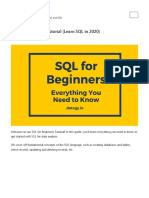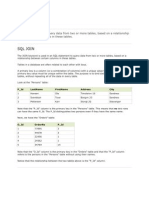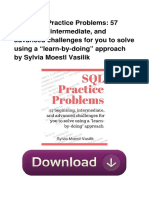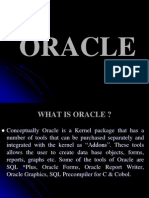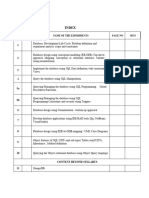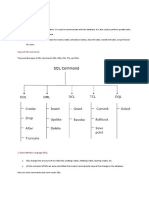Introduction To SQL
Uploaded by
vipul123patel123Introduction To SQL
Uploaded by
vipul123patel123SQL concepts
Structured Q Query L Language This language provides interface to relational database systems. It was developed by IBM in 1970. It is often pronounced as SEQUEL.
SQL
also encompasses DML(Data Manipulation Language), for INSERTs, UPDATEs, DELETEs. It also encompasses DDL(Data Definition Language), for creating tables and other data structures. SQL has been a command language for communication with Oracle 9i server. When an SQL statement is entered it remains in a part of memory called SQL buffer, until a new SQL statement is entered.
SQL starts with a verb( i.e SQL action word). Example: SELECT statements. This verb may have additional adjectives. Example: FROM. Each verb is followed by number of clauses. Example: FROM, WHERE, HAVING. A space separates clauses. Example DROP TABLE EMP;
A comma separates parameters without clause. A ; is used to end SQL statements. Statements may be split across lines but keywords may not. Identifiers can contain up to 30 characters and must start with an alphabetic character. Character and date literals must be enclosed within single quotes.
DDL(Data Definition Language) Set of SQL commands used to create, modify and delete database structures but not data. They are normally used by DBA, database designer or application developer. They are not susceptible to rollback. DML(Data Manipulation Language) It is the area of SQL which allows changing data within database.
DCL(Data Control Language) Component of SQL statement that control access to data and to the database. Occasionally, DCL statements are grouped with DML statements. DQL(Data Query Language) It is the component of SQL statement that allows getting data from database and imposing ordering upon it. It allows performing operations on data obtained from the database.
CREATE: To create objects in the database. ALTER: Alters the structure of the database. DROP: Delete objects from the database TRUNCATE: Remove all records from a table, including all spaces allocated for the records are removed. COMMENT: Add comments to the data dictionary. GRANT: Gives users access privileges to database REVOKE: Withdraw access privileges given with the GRANT command
INSERT: Insert data into a table UPDATE: Updates existing data within a table DELETE: Deletes all records from a table, the space for the records remain. CALL: Call a PL/SQL or Java subprogram. EXPLAIN PLAN: Explain access path to data LOCK: TABLE Control concurrency
COMMIT: Save work done SAVEPOINT: Identify a point in a transaction to which you can later roll back. ROLLBACK: Restore database to original since the last COMMIT SET TRANSACTION: Change transaction options like what rollback segment to use. GRANT/REVOKE: Grant or take back permissions to or from the oracle users.
Syntax:
CREATE TABLE <TableName> (<ColumnName1> <DataType>(<size>), <ColumnName2> <DataType>(<size>));
Checklist When Creating Tables
What
are the attributes of the rows to be stored? What are the data types of the attributes? Which columns should be used to build the primary key? Which columns do (not) allow null values?
Syntax:
INSERT
INTO <tablename> (<columnname1>, <columnname2>) values(<expression>, <expression2>);
In INSERT INTO SQL statement, table columns and values have a one to one relationship. i.e first value is inserted in first column, second value is inserted in second column and so on.
If there are exactly same numbers of values as there are columns and the values are sequenced accordingly, then there is no need to indicate column names. However, if there are less values than the columns in the table then it is mandatory to indicate both the table column name and its corresponding value.
The SELECT command is used to retrieve rows selected from one or more tables. To retrieve data from all rows and all columns Syntax: SELECT * from <TableName>; Filtering table data
Three
ways of filtering table data are:
Selected columns and all rows Selected rows and all columns Selected columns and selected rows
Selected Columns and all Rows
Syntax:
SELECT <ColumnName1>, <ColumnName2> FROM <TableName>;
Selected Rows and all Columns
Syntax:
SELECT * from <TableName> WHERE <Condition>; Here, <condition> is quantified as <ColumnName = Value>
Selected Columns and Selected Rows
Syntax:
SELECT <ColumnName1>, <ColumnName2> FROM <TableName> WHERE <Condition>;
A table could hold duplicate rows. In order to view unique rows the DISTINCT clause can be used.
Syntax(For
mentioned columns): SELECT DISTINCT <ColumnName1>, <ColumnName2> FROM <TableName>; all columns): SELECT DISTINCT * FROM <TableName>;
Syntax(For
The rows retrieved from table can be sorted either in ascending or descending order.
Syntax:
SELECT * FROM <TableName> ORDER BY <ColumnName> <[Sort Order]>;
Syntax:
CREATE TABLE <TableName> (<ColumnName>, <ColumnName>) AS SELECT <ColumnName>, <ColumnName> FROM <TableName>;
To create a target table without the records from source table(i.e create structure only) the WHERE clause must specify a condition that cannot be satisfied.
Syntax:
INSERT INTO <TableName> SELECT <ColumnName1>, <ColumnNameN> FROM <TableName>;
Insert only selected data from Source Table to Target Table
Syntax:
INSERT INTO <TableName>(<Column1>, <ColumnN>) SELECT <Column1>, <ColumnN> FROM <TableName> WHERE <Condition>;
DELETE in SQL is used to remove either:
All
the rows from a table OR A set of rows from a table.
Syntax(Removal
of all rows): DELETE FROM <TableName>; of specific rows(s)): DELETE FROM <TableName> WHERE <Condition>;
Syntax(Removal
UPDATE command is used to change or modify data values in a table. UPDATE in SQL is used to either update:
All
the rows from a table OR A selected set rows from a table
Syntax(Updating
all rows): UPDATE <TableName> SET <Column1> = <Expression1>, <Column2> = <Expression2>;
Syntax(Update
records conditionally): UPDATE <TableName> SET <Column1> = <Expression1>, <Column2> = <Expression2> WHERE <Condition>;
It is used to modify the structure of a table. It allows changing the structure of existing table. With ALTER TABLE it is possible:
To add or delete columns, Change data type of existing columns, Rename columns or the table itself.*
ALTER TABLE works by making temporary copy of the original table.
Adding new columns
Syntax:
ALTER TABLE <TableName> ADD(<NewColumn> <Datatype>(<Size>), <NewColumn> <Datatype>(<Size>));
Dropping Single Column from a table:
Syntax:*
ALTER TABLE <TableName> DROP COLUMN <Column1>;
Dropping
Multiple columns from the table ALTER TABLE <TableName> DROP (<Column1>, <Column2>,..); existing columns* ALTER TABLE <TableName> MODIFY (<Column> <NewDatatype>(<NewSize>));
Modifying
The following cannot be performed using ALTER TABLE clause:
Change
the name of the table. Decrease the size of a column if table data exists.
To rename a table, the syntax is
Syntax:
RENAME <TableName> TO <NewTableName>;
TRUNCATE TABLE empties a table completely.
Syntax: TRUNCATE
TABLE <TableName>;
Logically it is similar to DELETE but there are some differences:
Truncate
operations drop and re-create the table, which is much faster than deleting rows one by one. Truncate operations are not transaction-safe. Deleted rows cannot be returned.
To destroy or discard a table DROP TABLE is used.
Syntax:
DROP TABLE <TableName>;
A synonym is an alternative name for objects such as tables, views, sequences, stored procedures, and other database objects.
Syntax: CREATE [PUBLIC] SYNONYM SYNONYM_NAME FOR OBJECT_NAME;
Syntax:
DROP [PUBLIC] SYNONYM SYNONYM_NAME;
To display all the tables in the current tablespace.
Syntax: SELECT * FROM TAB;
To display information about columns in a table.
Syntax: DESCRIBE <TableName>;
You might also like
- SQL - With Practice Exercises, Learn SQL Fast (PDFDrive) PDF100% (1)SQL - With Practice Exercises, Learn SQL Fast (PDFDrive) PDF167 pages
- PDF Book SQL Practice Problems 57 Beginn PDFNo ratings yetPDF Book SQL Practice Problems 57 Beginn PDF3 pages
- Ex - No-1 Data Definition, Table Creation, ConstraintsNo ratings yetEx - No-1 Data Definition, Table Creation, Constraints14 pages
- SQL For Beginners Tutorial (Learn SQL in 2020) - DatagyNo ratings yetSQL For Beginners Tutorial (Learn SQL in 2020) - Datagy27 pages
- MySQL Tutorial - MySQL by Examples For Beginners PDFNo ratings yetMySQL Tutorial - MySQL by Examples For Beginners PDF36 pages
- Excel Function Dictionary 150 Example Functions and Formula100% (1)Excel Function Dictionary 150 Example Functions and Formula3 pages
- Design & Build A Microsoft Office Access Database100% (7)Design & Build A Microsoft Office Access Database150 pages
- SQL Joins Tutorial: Cross Join, Full Outer Join, Inner Join, Left Join, and Right JoinNo ratings yetSQL Joins Tutorial: Cross Join, Full Outer Join, Inner Join, Left Join, and Right Join22 pages
- SEARCH EBOOK SQL Practice Problems 57 Be PDF0% (1)SEARCH EBOOK SQL Practice Problems 57 Be PDF3 pages
- CTE (Common Table Expression) & Recursive CTE100% (1)CTE (Common Table Expression) & Recursive CTE14 pages
- SQL Programming For Beginners The Ultimate Beginners Guide To Analyze and Manipulate Data With SQL (2020)No ratings yetSQL Programming For Beginners The Ultimate Beginners Guide To Analyze and Manipulate Data With SQL (2020)88 pages
- SQL Query Interview Questions With Answers100% (1)SQL Query Interview Questions With Answers16 pages
- Triggers: Birla Institute of Technology and Science, Pilani Database Systems Lab No #8No ratings yetTriggers: Birla Institute of Technology and Science, Pilani Database Systems Lab No #811 pages
- MYSQL IP Notes For Class 11 Chapter 9 Download PDF100% (1)MYSQL IP Notes For Class 11 Chapter 9 Download PDF6 pages
- Unit 1-Introduction To Database SystemsNo ratings yetUnit 1-Introduction To Database Systems36 pages
- Oracle 11 G (SQL) : Quality Thought TechnologiesNo ratings yetOracle 11 G (SQL) : Quality Thought Technologies127 pages
- DBMS OS CN OOPs MostFrequentlyAskedQuestionsNo ratings yetDBMS OS CN OOPs MostFrequentlyAskedQuestions91 pages
- ,C#,MVC, Sqlserver, Jquery, WCF Interview Question AnswerNo ratings yet,C#,MVC, Sqlserver, Jquery, WCF Interview Question Answer86 pages
- Dbms Notes by Bipul Kumar Yadav - 1581657091 PDFNo ratings yetDbms Notes by Bipul Kumar Yadav - 1581657091 PDF121 pages
- SQL - With Practice Exercises, Learn SQL Fast (PDFDrive) PDFSQL - With Practice Exercises, Learn SQL Fast (PDFDrive) PDF
- Ex - No-1 Data Definition, Table Creation, ConstraintsEx - No-1 Data Definition, Table Creation, Constraints
- SQL For Beginners Tutorial (Learn SQL in 2020) - DatagySQL For Beginners Tutorial (Learn SQL in 2020) - Datagy
- MySQL Tutorial - MySQL by Examples For Beginners PDFMySQL Tutorial - MySQL by Examples For Beginners PDF
- Excel Function Dictionary 150 Example Functions and FormulaExcel Function Dictionary 150 Example Functions and Formula
- SQL Joins Tutorial: Cross Join, Full Outer Join, Inner Join, Left Join, and Right JoinSQL Joins Tutorial: Cross Join, Full Outer Join, Inner Join, Left Join, and Right Join
- SQL Programming For Beginners The Ultimate Beginners Guide To Analyze and Manipulate Data With SQL (2020)SQL Programming For Beginners The Ultimate Beginners Guide To Analyze and Manipulate Data With SQL (2020)
- Triggers: Birla Institute of Technology and Science, Pilani Database Systems Lab No #8Triggers: Birla Institute of Technology and Science, Pilani Database Systems Lab No #8
- MYSQL IP Notes For Class 11 Chapter 9 Download PDFMYSQL IP Notes For Class 11 Chapter 9 Download PDF
- ,C#,MVC, Sqlserver, Jquery, WCF Interview Question Answer,C#,MVC, Sqlserver, Jquery, WCF Interview Question Answer













